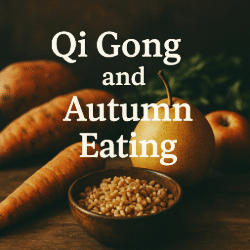Qi Gong & Autumn Eating — Practical FAQ
1) What does “Metal phase” (autumn) mean for everyday meals?
Focus on warm, cooked foods that support lungs and large intestine: roasted roots (carrot, beet, sweet potato), moistening fruits (pear, apple), and moderate whole grains (oats, barley, brown rice). Aim for 2/3 plate cooked foods, 1/3 fresh or lightly steamed.
2) Give me one specific, seasonal lunch I can make in 15 minutes.
Ginger-Pear Barley Bowl (serves 1): warm 1 cup cooked barley with 1 tsp grated ginger and 1 tsp tamari; top with ½ sliced Asian pear, ½ cup steamed bok choy, 1 tbsp toasted sesame seeds. Optional: add 3–4 oz baked tofu.
3) How much grain is “enough” without feeling heavy?
Start with ½–1 cup cooked grain per meal (90–180 g). If you feel sluggish or bloated after 2 hours, reduce by ¼ cup next time or swap to lighter grains (millet, oats) and extend chew time to 20–30 chews per bite.
4) What cooking methods fit the season?
Prioritize roasting (375–400°F / 190–205°C, 25–35 min), stewing, and steaming. These methods warm, concentrate flavors, and ease digestion. Limit cold smoothies/salads; if used, pair with warm tea or soup.
5) Which flavors support the lungs without irritation?
Use mild pungent (ginger, scallion, daikon, garlic) in small amounts to open the chest and clear damp. Avoid excessive chilies or alcohol, which scatter qi. Balance pungent with moistening foods (pear, honey, tofu, sesame).
6) I’m an older adult—how should I adapt the meal plan?
Favor soups and stews; choose lighter grains (millet, oats) at
½ cup cooked portions; add moistening foods daily (pear, cooked greens, a tsp honey if tolerated). Practice 10–15 minutes of gentle breathwork before dinner to support appetite and digestion.
Medication note: If on blood thinners or ACE inhibitors, moderate high-vitamin K greens and check with your clinician before adding concentrated ginger/garlic.
7) Can I use sweet potatoes and beets if I’m watching blood sugar?
Yes—pair ½ cup roasted sweet potato or beet with protein/fat (tofu, salmon, tahini) and fiber (greens, barley). Roast instead of mashing to lower glycemic impact; add vinegar or lemon at the table to further blunt post-meal glucose rise.
8) What are 5 pantry staples that make autumn cooking automatic?
- Whole grains: oats, barley, brown rice (pre-cooked and frozen in flat bags).
- Roots: carrots, beets, sweet potatoes (keep scrubbed and ready).
- Aromatics: ginger, garlic, scallion.
- Moistening: Asian pears, honey, sesame oil.
- Protein: lentils, firm tofu, canned salmon or chickpeas.
9) How do I know the transition is working for me?
Within 7–10 days: steadier energy across the afternoon, easier morning elimination, less chest tightness/dry cough, and warmer hands/feet after meals. If you notice persistent bloating, constipation >48 hours, or cough with fever, consult a licensed clinician.


